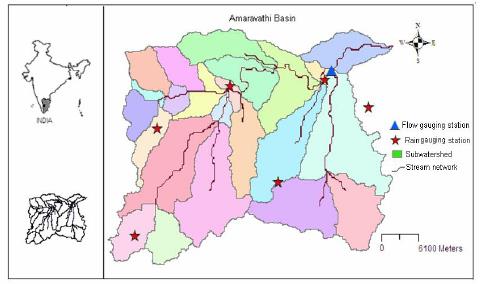
Professor & Head,
Maize Research Station,
Vagarai - 624 613.
Office No: 04545 – 292900
Fax: 04545 – 267373
E mail ID: arsvagarai@tnau.ac.in
The River Amaravathi (Fig.1) is one among the main tributaries of the river Cauvery, in its mid reach. It rises from Naimakad at an elevation of 2300 m above MSL in the Western Ghats (Anaimalai) in Idukki District of Kerala State. It flows towards northeast till the confluence with the river Cauvery on its right bank. Throughout its course of 256 km, the Amaravathi receives a number of small streams. The Amaravathi basin lies between the latitudes 10°06’51” N and 11°02’10” N and longitudes 77°03’24”E and 78°13’06” E. It has a catchment area of 8280 km2 constituting of four districts namely Coimbatore, Erode, Dindigul and Karur in Tamil Nadu.
The basin has four distinct seasons, South West monsoon from June to September, North East monsoon from October to December, the winter season from January to February and summer from March to May. The highest monthly mean of daily maximum temperature is around 40.6°C in April and the lowest monthly mean of daily minimum temperature is 22.4°C during January. The maximum average wind speed is 32.6 kmph in the month of June. The minimum average wind speed is 9.5 kmph in November. The monthly potential evapotranspiration value varies from as low as 66 mm in November to as high as 130.9 mm in May.
The Amaravathi basin has two distinct topographical features. The hilly terrain occupies the southern, southwestern and western part of the basin between the elevation 2300 m and 500 m and the undulating plains with stray hillocks lie between 500 m and 40 m. The basin is more or less fan shaped and has a length of about 188 km from west to east and an average width of 81 km from south to north. Generally, surface water drains from the south western hilly area towards the plain area in the north east. The basin area is underlained by the crystalline complex of Archaen age. The oldest of the rock types in the basin comprises of Granite, Gneiss, Khondalite, Charnockite, Ultramafic and associated intrusive rocks. The hard rock aquifers are fairly heterogeneous as indicated by the variations in lithology, structure and texture within short distances. The occurrence and movement of ground water mainly depends on the degree of weathering, topography, extent of fracture zones, etc. The important hard rock aquifers noticed are the weathered gneiss of Coimbatore, weathered and jointed charnockite and khondalite of Coimbatore. The precipitation in the study area is moderate to high intensity, long duration rainfall resulting in floods that have disastrous effects on property and human life. The rainfall for the months from January to April is not significant. The average annual rainfall of the basin is 1029 mm.
Particulars |
Dindigul |
Karur |
Tiruppur |
Total |
Fully irrigated area |
13275.37 ha |
6026.31 ha |
16392.61 ha |
35694.29 ha |
Partially irrigated area |
2583.11 ha |
1086.60 ha |
4906.07 ha |
8575.78 ha |
Gap |
3634.30 ha |
1767.11 ha |
2536.33 ha |
7937.74 ha |
Permenant Gap |
559.81 ha |
405.98 ha |
160.62 ha |
1126.40 ha |
Total ayacut area |
20052.59 ha |
9286.00 ha |
23995.63 ha |
53334.22 ha |
Sl.No. |
Name of the Intervention |
Yield Details (kg ha-1) |
% of increase over control |
|||||
2012-13 |
2013-14 |
Mean |
||||||
Control |
Treatment |
Control |
Treatment |
Control |
Treatment |
|||
1. |
GM+SRI+RFP |
7125 |
8720 |
6889 |
8211 |
7007 |
8466 |
21 |
2. |
MMC |
6675 |
8787 |
7484 |
9276 |
7080 |
9032 |
28 |
3. |
GLP |
616 |
845 |
603 |
818 |
610 |
832 |
36 |
4. |
PFV |
20069 |
25246 |
18126 |
25395 |
19098 |
25321 |
33 |
5. |
SSI |
86360 |
112900 |
84845 |
111000 |
85603 |
111950 |
31 |